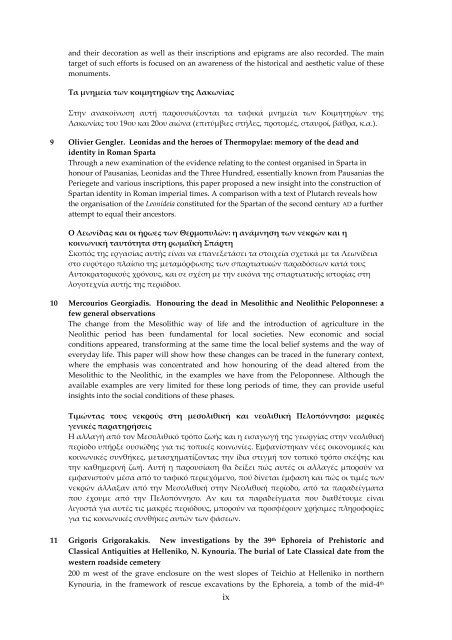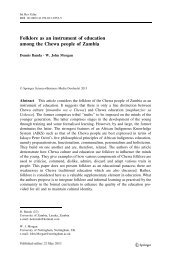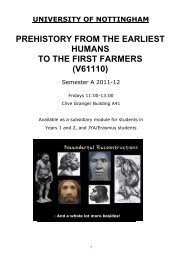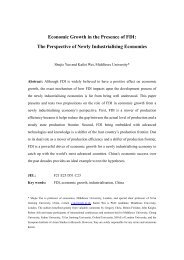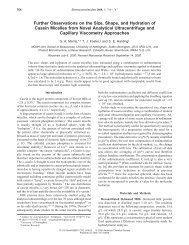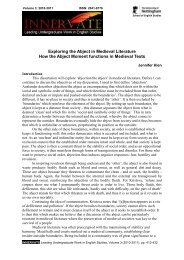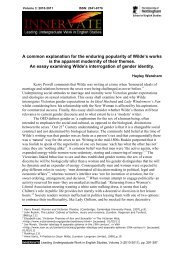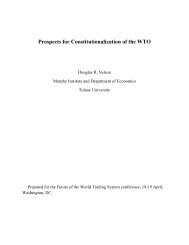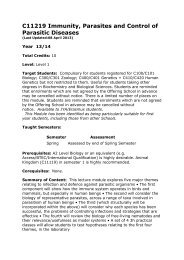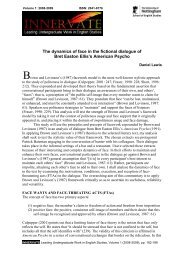Honouring the Dead in the Peloponnese - University of Nottingham
Honouring the Dead in the Peloponnese - University of Nottingham
Honouring the Dead in the Peloponnese - University of Nottingham
Create successful ePaper yourself
Turn your PDF publications into a flip-book with our unique Google optimized e-Paper software.
and <strong>the</strong>ir decoration as well as <strong>the</strong>ir <strong>in</strong>scriptions and epigrams are also recorded. The ma<strong>in</strong><br />
target <strong>of</strong> such efforts is focused on an awareness <strong>of</strong> <strong>the</strong> historical and aes<strong>the</strong>tic value <strong>of</strong> <strong>the</strong>se<br />
monuments.<br />
Τα μνημεία των κοιμητηρίων της Λακωνίας<br />
Στην ανακοίνωση αυτή παρουσιάζονται τα ταφικά μνημεία των Κοιμητηρίων της<br />
Λακωνίας του 19ου και 20ου αιώνα (επιτύμβιες στήλες, προτομές, σταυροί, βάθρα, κ.α.).<br />
9 Olivier Gengler. Leonidas and <strong>the</strong> heroes <strong>of</strong> Thermopylae: memory <strong>of</strong> <strong>the</strong> dead and<br />
identity <strong>in</strong> Roman Sparta<br />
Through a new exam<strong>in</strong>ation <strong>of</strong> <strong>the</strong> evidence relat<strong>in</strong>g to <strong>the</strong> contest organised <strong>in</strong> Sparta <strong>in</strong><br />
honour <strong>of</strong> Pausanias, Leonidas and <strong>the</strong> Three Hundred, essentially known from Pausanias <strong>the</strong><br />
Periegete and various <strong>in</strong>scriptions, this paper proposed a new <strong>in</strong>sight <strong>in</strong>to <strong>the</strong> construction <strong>of</strong><br />
Spartan identity <strong>in</strong> Roman imperial times. A comparison with a text <strong>of</strong> Plutarch reveals how<br />
<strong>the</strong> organisation <strong>of</strong> <strong>the</strong> Leonideia constituted for <strong>the</strong> Spartan <strong>of</strong> <strong>the</strong> second century AD a fur<strong>the</strong>r<br />
attempt to equal <strong>the</strong>ir ancestors.<br />
Ο Λεωνίδας και οι ήρωες των Θερμοπυλών: η ανάμνηση των νεκρών και η<br />
κοινωνική ταυτότητα στη ρωμαϊκή Σπάρτη<br />
Σκοπός της εργασίας αυτής είναι να επανεξετάσει τα στοιχεία σχετικά με τα Λεωνίδεια<br />
στο ευρύτερο πλαίσιο της μεταμόρφωσης των σπαρτιατικών παραδόσεων κατά τους<br />
Αυτοκρατορικούς χρόνους, και σε σχέση με την εικόνα της σπαρτιατικής ιστορίας στη<br />
λογοτεχνία αυτής της περιόδου.<br />
10 Mercourios Georgiadis. <strong>Honour<strong>in</strong>g</strong> <strong>the</strong> dead <strong>in</strong> Mesolithic and Neolithic <strong>Peloponnese</strong>: a<br />
few general observations<br />
The change from <strong>the</strong> Mesolithic way <strong>of</strong> life and <strong>the</strong> <strong>in</strong>troduction <strong>of</strong> agriculture <strong>in</strong> <strong>the</strong><br />
Neolithic period has been fundamental for local societies. New economic and social<br />
conditions appeared, transform<strong>in</strong>g at <strong>the</strong> same time <strong>the</strong> local belief systems and <strong>the</strong> way <strong>of</strong><br />
everyday life. This paper will show how <strong>the</strong>se changes can be traced <strong>in</strong> <strong>the</strong> funerary context,<br />
where <strong>the</strong> emphasis was concentrated and how honour<strong>in</strong>g <strong>of</strong> <strong>the</strong> dead altered from <strong>the</strong><br />
Mesolithic to <strong>the</strong> Neolithic, <strong>in</strong> <strong>the</strong> examples we have from <strong>the</strong> <strong>Peloponnese</strong>. Although <strong>the</strong><br />
available examples are very limited for <strong>the</strong>se long periods <strong>of</strong> time, <strong>the</strong>y can provide useful<br />
<strong>in</strong>sights <strong>in</strong>to <strong>the</strong> social conditions <strong>of</strong> <strong>the</strong>se phases.<br />
Τιμώντας τους νεκρούς στη μεσολιθική και νεολιθική Πελοπόννησο: μερικές<br />
γενικές παρατηρήσεις<br />
Η αλλαγή από τον Μεσολιθικό τρόπο ζωής και η εισαγωγή της γεωργίας στην νεολιθική<br />
περίοδο υπήρξε ουσιώδης για τις τοπικές κοινωνίες. Εμφανίστηκαν νέες οικονομικές και<br />
κοινωνικές συνθήκες, μετασχηματίζοντας την ίδια στιγμή τον τοπικό τρόπο σκέψης και<br />
την καθημερινή ζωή. Αυτή η παρουσίαση θα δείξει πώς αυτές οι αλλαγές μπορούν να<br />
εμφανιστούν μέσα από το ταφικό περιεχόμενο, πού δίνεται έμφαση και πώς οι τιμές των<br />
νεκρών άλλαξαν από την Μεσολιθική στην Νεολιθική περίοδο, από τα παραδείγματα<br />
που έχουμε από την Πελοπόννησο. Αν και τα παραδείγματα που διαθέτουμε είναι<br />
λιγοστά για αυτές τις μακρές περιόδους, μπορούν να προσφέρουν χρήσιμες πληροφορίες<br />
για τις κοινωνικές συνθήκες αυτών των φάσεων.<br />
11 Grigoris Grigorakakis. New <strong>in</strong>vestigations by <strong>the</strong> 39 th Ephoreia <strong>of</strong> Prehistoric and<br />
Classical Antiquities at Helleniko, N. Kynouria. The burial <strong>of</strong> Late Classical date from <strong>the</strong><br />
western roadside cemetery<br />
200 m west <strong>of</strong> <strong>the</strong> grave enclosure on <strong>the</strong> west slopes <strong>of</strong> Teichio at Helleniko <strong>in</strong> nor<strong>the</strong>rn<br />
Kynouria, <strong>in</strong> <strong>the</strong> framework <strong>of</strong> rescue excavations by <strong>the</strong> Ephoreia, a tomb <strong>of</strong> <strong>the</strong> mid-4 th<br />
ix


